We don’t know precisely what the future will look like, but we know that it will look different. Often we think we’ve reached our limits, though we don’t truly know where our limits lie. If we’re lucky, the future will lap us and laugh at us. We should welcome that. From a post by Stuart Armstrong at Practical Ethics:
“In 1920, Jackson Scholz set the men’s 100m world record at 10.6 seconds. The 100m race is one where progress is very hard; we’re getting towards the limit of human possibility. It’s very tricky to squeeze out another second or fraction of a second. Still, in 2009, Usain Bolt set the men’s 100m world record at 9.58 seconds.
Apart from the Bolt, who else today can run faster than Jackson Scholz? Well, the fastest 16 year old ran the 100m in 10.27 second. The visually impaired world record is 10.46seconds. The woman’s world record is 10.49 seconds.
The point of this extended metaphor is that we are focused on the differences we see today: between teenagers and adults, between men and women, between the able-bodied and those not. But the difference that swamps all of these is the difference between the present and the past.”

